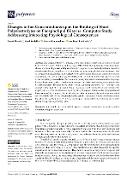Changes in Ion Concentrations upon the Binding of Short Polyelectrolytes on Phospholipid Bilayers: Computer Study Addressing Interesting Physiological Consequences

Datum vydání
2022Publikováno v
PolymersRočník / Číslo vydání
14 (17)ISBN / ISSN
ISSN: 2073-4360Metadata
Zobrazit celý záznamKolekce
Tato publikace má vydavatelskou verzi s DOI 10.3390/polym14173634
Abstrakt
This computer study was inspired by the experimental observation of Y. Qian et al. published in ACS Applied Materials and Interfaces, 2018 that the short positively charged β-peptide chains and their oligomeric analogues efficiently suppress severe medical problems caused by antimicrobial drug-resistant bacteria despite them not penetrating the bacterial membrane. Our coarse-grained molecular dynamics (dissipative particle dynamics) simulations confirm the tentative explanation of the authors of the experimental study that the potent antimicrobial activity is a result of the entropically driven release of divalent ions (mainly magnesium ions essential for the proper biological function of bacteria) into bulk solution upon the electrostatic binding of β-peptides to the bacterial membrane. The study shows that in solutions containing cations Na(+), Ca(2+) and Mg(2+), and anions Cl(-), the divalent cations preferentially concentrate close to the membrane and neutralize the negative charge. Upon the addition of positively charged oligomer chains (models of β-peptides and their analogues), the oligomers electrostatically bind to the membrane replacing divalent ions, which are released into bulk solvent. Our simulations indicate that the entropy of small ions (which controls the behavior of synthetic polyelectrolyte solutions) plays an important role in this and also in other similar biologically important systems.
Klíčová slova
lipid membrane, antimicrobial peptides, computer simulations, dissipative particle dynamics, entropy of counterions
Trvalý odkaz
https://hdl.handle.net/20.500.14178/1905Licence
Licence pro užití plného textu výsledku: Creative Commons Uveďte původ 4.0 International







